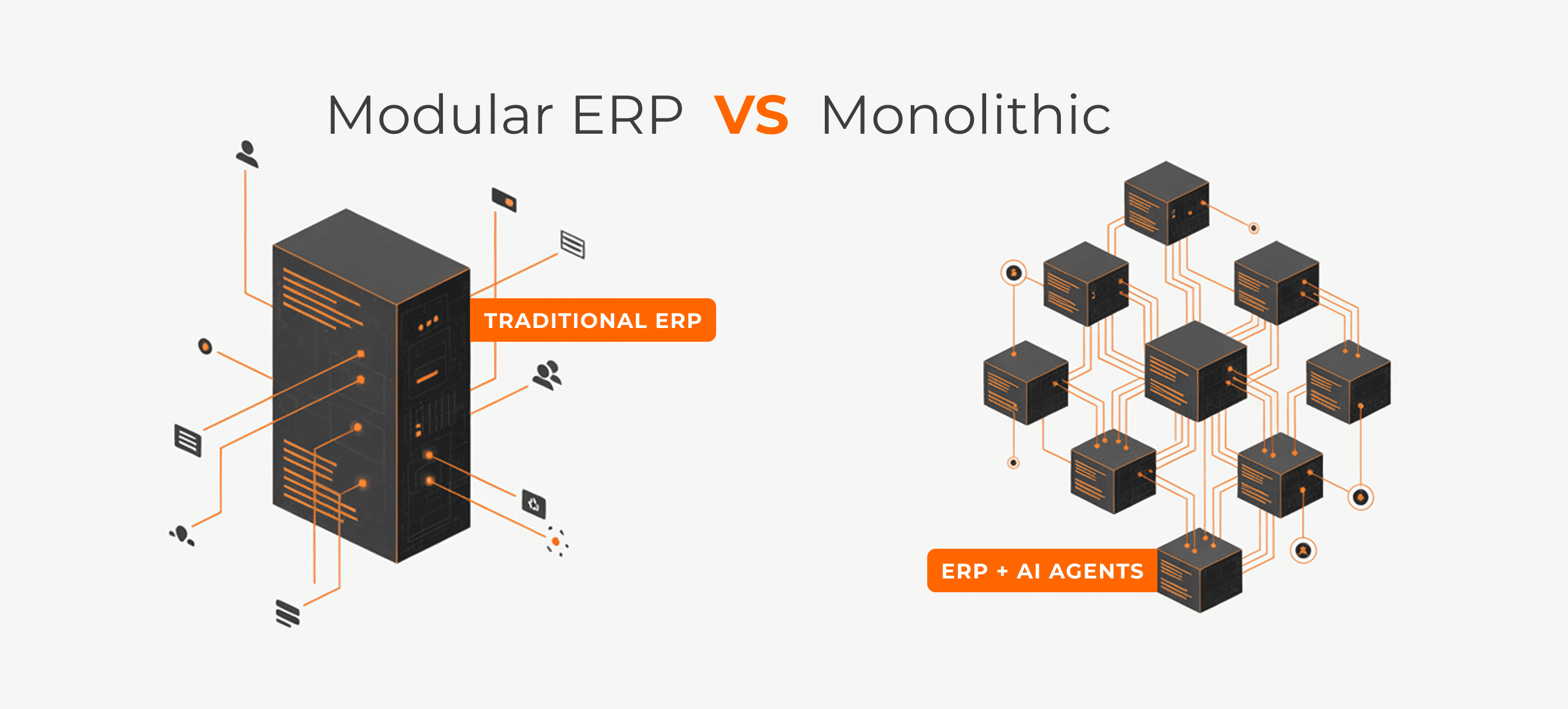The Silent Dissolution: How AI Is Rewriting the Future of ERP Systems

For decades, Enterprise Resource Planning (ERP) systems have occupied the gravitational center of business operations. These monolithic platforms promised integration, standardization, and total control over organizational processes. From SAP revolutionizing manufacturing operations in the 1990s to the cloud-first solutions of the last decade, ERP has maintained its position as the technological backbone of enterprises.
However, a fundamental transformation is taking place behind corporate curtains, far from the spotlight of major tech conferences. This is not an incremental evolution or a new software release. What we are witnessing is a profound architectural reconfiguration: traditional ERP is being silently dissolved by artificial intelligence, not as a direct replacement, but as a complete reimagination of its function and relevance within the enterprise ecosystem.
This shift is not merely technical; it represents a paradigmatic change in how organizations process information, make decisions, and execute operations. The human interface layer, once represented by static dashboards and rigid forms, is being replaced by intelligent conversational agents that understand context, anticipate needs, and autonomously execute complex tasks.
The Invisible Metamorphosis: From Centerpiece to Infrastructure
This ongoing transformation can be understood through an analogy with the evolution of urban infrastructure. Just as electricity evolved from being a spectacle at fairs to becoming invisible and ubiquitous, ERP is experiencing a similar dissolution. The key difference is that, while electricity became physical infrastructure, ERP is turning into cognitive infrastructure.
Generative AI agents are not simply automating existing processes; they are recreating the operational logic of organizations. Financial reconciliation, traditionally a manual, labor-intensive process consuming days of accounting work, is now executed by algorithms that identify discrepancies, propose corrections, and, in many cases, implement solutions without human intervention. The monthly accounting close, a ritual that once mobilized entire teams, is being compressed into continuous, real-time processes.
This transformation is particularly evident in reporting and forecasting. Static dashboards, which offered snapshots of the past, are being replaced by dynamic, AI-generated narratives. These not only present what happened, but explain why it happened, suggest what should happen next, and increasingly, act on those insights.
The New Cognitive Enterprise Architecture
The emerging architecture does not eliminate the need for robust backend systems; it radically redefines the interface between technology and the user. Traditional ERP systems, with their complex interfaces and rigid workflows, are becoming layers of data and business logic feeding specialized intelligent agents.
Each department now interacts with its own manifestation of enterprise intelligence. The finance department operates through assistants that understand accounting nuances, tax regulations, and internal policies. Supply chain management is handled by agents that monitor suppliers, predict disruptions, and optimize inventories in real time. Sales teams work with AI that analyzes patterns, identifies opportunities, and suggests pricing strategies.
This departmental specialization marks a significant evolution from the “one-size-fits-all” approach of traditional ERPs. Each agent not only accesses centralized data but develops contextual expertise, learning from the particularities and needs of its domain.
Continuous Learning as a Competitive Advantage
The most transformative aspect of this new architecture is its capacity for continuous learning. While traditional ERPs required expensive and time-consuming customizations to adapt to organizational change, AI-based systems evolve organically through daily interaction with users and data.
This learning is not superficial. Agents develop a deep understanding of seasonal patterns, customer behaviors, operational efficiencies, and emerging risks. More importantly, they can correlate insights across departments in ways that eluded traditional human analysis.
A financial agent, for instance, might discover that increased marketing expenses correlate with reduced customer acquisition costs, but only in specific geographic regions during certain times of the year. This level of granular analysis, combined with the ability to act upon insights, represents a qualitative leap in operational intelligence.
Modularity and Interoperability: The New Imperatives

The dissolution of the monolithic ERP creates both opportunities and challenges for established vendors. Those who recognize this new reality are redesigning their architectures to function as modular ecosystems, where specific functionalities can be accessed and orchestrated by external agents.
This modularity is not only technical; it is strategic. Companies that keep their platforms open and interoperable can integrate into the new AI-driven business ecosystem. Their functionalities become components of a greater intelligence, maintaining relevance through the quality of their data and processes.
Conversely, vendors that persist with proprietary and closed approaches are finding themselves increasingly isolated. Their systems become data silos inaccessible to intelligent agents, losing relevance as organizations migrate toward more flexible and responsive architectures.
Implications for Business Management
This transformation fundamentally redefines the role of business managers and analysts. Their function evolves from operational to strategic, from executional to supervisory. Managers no longer spend time compiling reports or performing reconciliations; they focus on interpreting insights, defining decision parameters for autonomous agents, and orchestrating complex strategies.
This shift requires new competencies. The ability to interact effectively with AI agents, understanding their limitations and potential, and to set appropriate guardrails becomes critical. Managers must develop fluency in enterprise prompt engineering: the art of crafting instructions and contexts that maximize AI effectiveness.
Simultaneously, governance and compliance gain new layers of complexity. How do you audit decisions made by autonomous agents? How do you ensure regulatory compliance in processes that continuously evolve? How do you maintain transparency in increasingly automated operations? These questions define a new frontier in technological risk management.
Resistance and Transition Challenges
The migration toward AI-based architectures is not without obstacles. Organizational resistance is significant, particularly among professionals whose roles are directly affected by automation. The learning curve for effective interaction with intelligent agents can be steep, especially in organizations with conservative technology cultures.
Technical challenges are also considerable. Data quality becomes critical when algorithms rely on it for autonomous decision-making. Organizations with fragmented, inconsistent, or low-quality data face serious difficulties in implementing AI-driven solutions.
Security and privacy concerns gain new dimensions when autonomous agents access and process sensitive information. Balancing operational efficiency with data protection creates tensions that demand sophisticated approaches to security architecture.
The Emerging Horizon: Cognitive Organizations
Looking beyond the current transition, the concept of truly cognitive organizations begins to emerge. In these entities, the distinction between human and automated processes dissolves into hybrid workflows where human and artificial intelligence collaborate seamlessly.
These organizations are characterized by extreme responsiveness to market changes, advanced predictive capabilities, and continuous operational optimization. They operate with reduced error margins, accelerated decision cycles, and adaptability that grants them sustainable competitive advantage.
In this context, ERP becomes completely invisible, a data infrastructure layer powering organizational intelligence without interfering with the user experience. Perceived value shifts definitively from system ownership to the quality of the intelligence that emerges from orchestration.
Conclusion
The transformation of ERP systems through artificial intelligence represents more than a technological evolution, it constitutes a fundamental reconfiguration of contemporary enterprise architecture. What we are witnessing is not the death of ERP, but its metamorphosis into invisible cognitive infrastructure powering a new generation of intelligent organizations.
This silent dissolution carries profound implications for technology vendors, business leaders, and professionals across sectors. Those who understand and adapt to this new reality are positioned to thrive in an increasingly automated and intelligent business environment. Those who resist or ignore these changes risk progressive irrelevance.
The migration of value from systems to the intelligence that orchestrates them marks a historical inflection point, comparable to the transition from mainframes to personal computing, or from desktop to cloud. Organizations that embrace modularity, interoperability, and continuous learning will inherit the competitive advantages of the AI-driven era.
The future of business will not be defined by the systems we own, but by the sophistication of the intelligence that emerges from their integration. In this context, ERP does not disappear, it evolves, dissolves into infrastructure, and reemerges as the nervous system of truly cognitive organizations. The question is not if this transformation will occur, but how quickly organizations and professionals will adapt to the new emerging reality.
